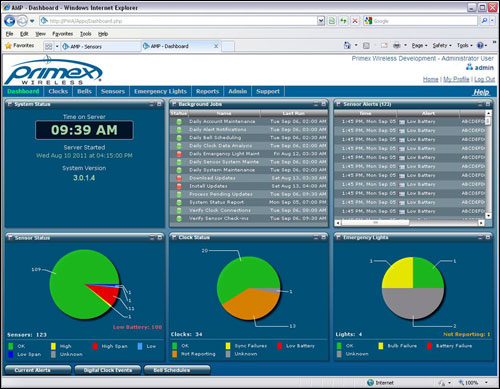Primex Wireless, a company focused on facility-monitoring solutions, including those that help hospitals comply with regulations, has released an emergency-light monitoring system as part of its Synchronous Network System (SNS) platform. The system employs Wi-Fisensors, as well as a solution for transmitting the status of a cardiopulmonary emergency (Code Blue), to a back-end system, in order to track how long a Code Blue situation lasts. The firm also offers a Wi-Fi-based temperature-monitoring solution for coolers and warmers. The new systems are currently being utilized by hundreds of hospitals, the company reports.
Primex Wireless, which has been in business for nearly four decades, offers facility-management solutions for the health-care industry, with 13,000 customers, hundreds of which are now using its wireless solutions to help them track data regarding their equipment and how it operates, as well as Code Blue details, according to Mike O’Brien, Primex Wireless’ director of product research and marketing. By using technology to automate data collection, he explains, hospitals are better able to meet regulatory requirements, while also improving staff efficiency since equipment would not need to be monitored manually.

Click here to view a larger version of this image.
The latest addition to the SNS platform enables a hospital to use its existing Wi-Fi network to collect information about the operational status of the emergency lights installed within its facilities. Without an automated solution such as this one—known as SNS Emergency Light Monitoring—a hospital’s facility-management staff must regularly check batteries and bulbs on emergency lights throughout its building or campus, to ensure that they are operating effectively and not nearing the end of their lifecycle, as is required by National Fire Protection Association (NFPA) regulations.
Primex Wireless supplies emergency lights and illuminated exit signs with built-in Wi-Fi transmitters and sensors to measure the current reaching the lamps. Because the testing of all emergency lights within a large hospital can require a great deal of Wi-Fi bandwidth, facility managers can schedule monthly or annual emergency light testing procedures, to begin automatically at specified times when the Wi-Fi network may be less in use, such as during the middle of the night. Each emergency light’s Wi-Fi tag transmits data to the hospital’s Wi-Fi nodes regarding the health of its battery and bulbs. That information is then forwarded back to the SNS software, which determines whether there are any problems, and notifies the maintenance staff accordingly. The technology, O’Brien says, can also be retrofitted into existing lighting, depending on a fixture’s age and style.
The SNS Code Blue Timer is designed to track the length of time that a Code Blue event lasts. When this type of life-threatening emergency occurs, knowing how long a patient has been in this condition can be vital to providing treatment. Primex Wireless’ solution is intended to automate that timing, so that timestamps identifying the beginning and end of the event can be collected and stored in the software, without any effort on the part of personnel focused on treating that individual.
The SNS Code Blue Timer can be mounted on a hospital’s existing patient-monitoring equipment. Medical equipment is already designed to send a 3 kHz “pulse” in the event that a Code Blue event is detected. The Code Blue Timer receives that pulse, thereby triggering the count-up to commence. It then begins recording the times of emergency procedures as a Code Blue event is underway, and also tracks when the event ends, to the second. The timer displays that time data on an LED screen on its face, and forwards the information to the software platform via Wi-Fi.
The temperature- and humidity-monitoring system has been in place for several years, O’Brien says, and eliminates the need for manual monitoring of temperature and humidity levels in such devices as refrigerators for food or medical products. Primex Wireless’ battery-operated Wi-Fi-based sensors detect changes in temperature or humidity levels, and send data to the back-end system at preset intervals. The company’s SNS Application Management Platform (AMP) software issues alerts to employees if sensor data falls outside of acceptable parameters (such as a cooler becoming too warm due to a door being left open). The sensors can also be used to obtain ambient temperature or humidity data, such as monitoring the environment within an operating room, and receiving alerts in the event that the sensor data is too high or low.
The company’s Event Monitor consists of wireless sensors that detect if a water leak occurs (such as from a water tank or a water heater), or if a cabinet door or window is left open with a contact sensor. In the case of detecting leaks, a sensor can be secured to the floor and transmit to an Event Monitor device located nearby. The sensor data is transmitted via Wi-Fi (it can also be sent via an Ethernet cable) to the SNS Event Monitoring software—which, in turn, forwards that information to the SNS AMP software, which interprets each event, and can issue an alert to the maintenance staff via text message or e-mail, if it determines that a response is necessary.


